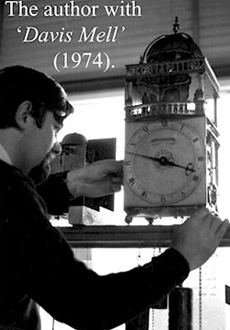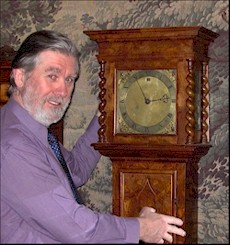|
Keith wKeith was born at Barnard Castle in1942, he was educated at The School and
frequented the adjoining Bowes Museum, with its famous Silver Swan
 .
The Bowes developed a love of fine arts and antiquarian studies. In a
military flying career (1960-1973), after the RAF College he flew in
fighter, instructor and solo-display roles, lastly on Harriers in Germany.
In 1968 he married Margaret, a tall Irish-Welsh girl, they have five adult
children, all involved in the arts to varying degrees. .
The Bowes developed a love of fine arts and antiquarian studies. In a
military flying career (1960-1973), after the RAF College he flew in
fighter, instructor and solo-display roles, lastly on Harriers in Germany.
In 1968 he married Margaret, a tall Irish-Welsh girl, they have five adult
children, all involved in the arts to varying degrees.
His study of antiquarian horology began while instructing in Wales, with a
private view of Lord Mostyn’s William III year spring-clock by Thomas
Tompion, later bought by the British Museum, the centre-piece of “Huygens
Legacy” at Apeldoorn in 2004. His interest was encouraged by a local Tompion
collector, and by very different horologists; J.Drummond Robertson, for his
penetrating historical perspectives; H.Alan Lloyd for his didactic approach
to the complexities of clockwork; and, of course, monographs on Tompion and
Knibb by R.W.Symonds and Ronald A Lee - whom he met and learned much from.

In 1973 he set up business in an old Dutch bank, as art and antique dealer,
entering a world of arbitrage and closed trusts; important old master
paintings and clocks passed through his hands. Holland then was fertile
ground to develop, meeting noted authors, collectors and dealers, who
together gave him a rare pan-european perspective. Willem Hana, the late
horologist and anglophile, was a great influence; so too is Dutch clock
restorer Berry van Lieshout, who shared his workshop and passion to record
and to preserve the horological heritage.
|
|
In 1976 Keith set up the customs and assay bonded ‘euro art centre’; he
promoted exhibitions, from early arms and armour, to an English museum’s
collection of Dutch & Flemish old masters - his first love. Keith has
recognised or discovered ‘lost’ masterpieces, both in fine art and horology.
In 1979 he appraised the ‘Tulip Tompion’, adding a naught to offers
received, it made the price. But in 1981 the financial climate reversed, he
had to sell up and the family returned to England.
Keith handled fine clocks; Fromanteel’s ebony Dutch longcase (now in the
H.M. Vehmeyer collection); the unique baroque gilt-wood Johannes van Ceulen
(its case now attributed to Daniel Marot); a silver Edward East repeating
clock (in the National Trust collections); Tompion’s two earliest
pre-Greenwich long duration movements; the last privately owned Charles Clay
organ clock; Wetherfield’s four-train musical clock by William Kipling. He
also advised in the restoration of Fromanteel’s earliest musical long-case
(c.1660-65), recovered properties, and has given expert evidence before
British Courts.
Keith disclaims being an ‘horologist’, being more comfortable as
‘antiquarian’. His illustrated reports, and ‘perspectives’ show his insights
into obtuse problems; like the 1657 Contract; and a Royal Hague-clock. He is
passionate about Ahasuerus Fromanteel, his ‘True Patriarch of English
Clock-making’, whose famous solar and musical masterpiece for Mr. Dudley
Palmer in 1649, last mentioned in Fromanteel’s workshop in 1684, he was
first to recognise, then decipher its mysteries. He greatly admires Johannes
van Ceulen, ‘The Dutch Tompion,’ whose collaborations with Christiaan
Huygens paralleled Tompion’s own with Robert Hooke.
He freely collaborates in research, but now prefers to work without
speculative pressure of dealing.
In this way, Keith
believes, he serves his adopted subject better.

link:
www.bowesmuseum.org.uk
|


